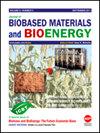Preparation and Surface Modification of Nanocellulose and Its Adsorption Performance on Cu2+
IF 0.5
4区 医学
引用次数: 0
Abstract
Nanocellulose fibers (NCFs) were converted to cellulose nanocrystals (CNCs) and then modified with diethylenetriamine pentaacetic acid (DTPA) to form modified CNCs (DTPA–CNCs), which were investigated as adsorbents for removing Cu2+ from aqueous solution. The adsorption behavior was affected by pH, contact time, dosage and raw Cu2+ concentration. Langmuir model is the best method to fit the adsorption isotherm of experimental results. The optimal conditions for Cu2+ adsorption were 2 h at 35 °C and pH 3, the optimal adsorption capacity is 94.5 mg/g. These functional groups on the DTPA–CNCs provided enhanced adsorption capacity, compared with unmodified NCFs.纳米纤维素的制备、表面改性及其对 Cu2+ 的吸附性能
研究人员将纳米纤维素纤维(NCFs)转化为纤维素纳米晶体(CNCs),然后用二乙烯三胺五乙酸(DTPA)对其进行改性,形成改性 CNCs(DTPA-CNCs),并将其作为从水溶液中去除 Cu2+ 的吸附剂。吸附行为受 pH 值、接触时间、用量和原始 Cu2+ 浓度的影响。Langmuir 模型是拟合实验结果吸附等温线的最佳方法。Cu2+ 的最佳吸附条件为 35 °C、pH 值为 3、接触时间为 2 小时,最佳吸附容量为 94.5 mg/g。与未改性的 NCFs 相比,DTPA-CNCs 上的这些官能团增强了吸附能力。
本文章由计算机程序翻译,如有差异,请以英文原文为准。
求助全文
约1分钟内获得全文
求助全文

 求助内容:
求助内容: 应助结果提醒方式:
应助结果提醒方式:


